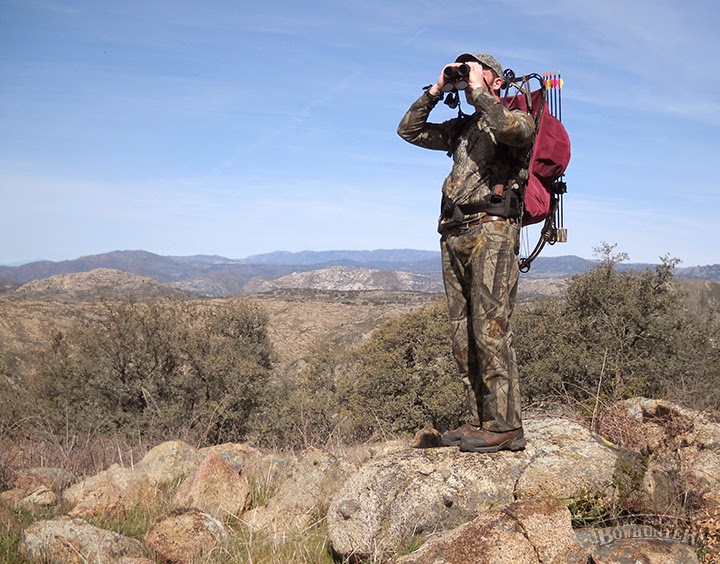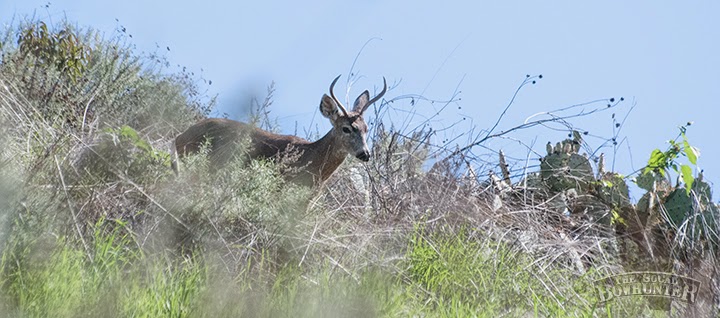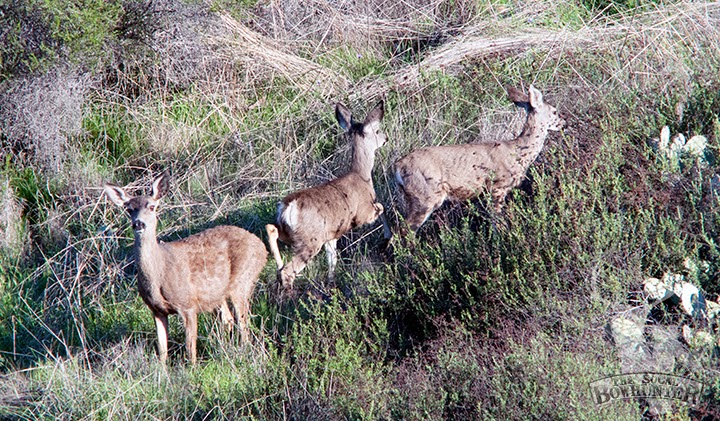 |
| Bowhunter Michael Giudici glasses for pigs in rugged terrain. |
Originally printed in the November issue of California Sportsman
Wisdom sometimes comes at a price. For me it was being stubborn and trying to apply only whitetail hunting tactics to hunting mule deer. Sometimes they work, but often they do not. Utilizing optics, for example, is one I learned the hard way. When I was younger, and hunted primarily whitetails from a treestand, I hardly ever used binoculars. I have truly grown to appreciate the benefits of quality optics for bowhunting. I have been bowhunting for 30 years, but I never truly grasped the importance of good optics until roughly six years ago. That’s when I started hunting the foothills and high desert areas of Southern California. The value of my optics far outweighs the price tag and it took some convincing.
Back in NY, I didn’t feel the need to routinely use binoculars or a spotting scope. I was 20 feet up in a tree waiting for a deer to walk by. I rarely used binoculars to locate deer in the farmers’ fields in hope I could set up a stand or ambush them from another direction. I was after meat first and antlers second. After my move to California, I found out most tags required me to shoot a minimum of a forked-horn buck. I figured any binoculars would work for glassing up these bucks. Deciding to continue to use my $25.00 pair, I couldn’t figure out why I would get headaches all the time. The simple truth is you get what you pay for and there is a reason why quality binoculars are more expensive. I was experiencing eye strain and eye fatigue due to the poor quality of my optics. I learned quickly that the binoculars I had were useless for hunting out West. Out here it’s about spotting your animal from a long distance (sometimes two miles or more) and then making an approach to spot and stalk. Plus, like many states, we have an antler restriction and having a quality binocular or spotting scope will help you determine if that buck is legal or not. Let your optics do some of the walking for you!
 |
| Although not a legal California buck, spotting this spike was exciting. |
As I have grown older and wiser, my choice in optics has improved. Most are fairly lightweight, crystal clear and are an incredible tool in helping me effectively spot animals. There are many high quality binoculars to choose from; Swarovski, MINOX, Nikon, Vortex, KOWA and Leica, just to name a few. At a minimum, I use a high quality 10×42 binocular because I don’t get eye fatigue and often glass for hours with them. They can reach out and give you a wide area to scan. Be sure to try out binoculars before you buy to be sure you are comfortable with them. Carefully consider your optics before you buy. If you try a few pair out and the one you like is out of your price range, save up for them! You do get what you pay for and you will be thankful you waited for the right pair.
 |
| It should come as no surprise that I hold my MINOX optics in high regard. |
For long range acquisition, many California hunters find a quality pair of 15×56 binoculars mounted to a tripod work best. Most hunters I know find them extremely useful and they can help you determine the legality a deer from a long way out. Unfortunately, the interpupillary distance (distance between the centers of the pupils of your eyes) doesn’t allow me to comfortably appreciate 15×56 binoculars. That being said, most of my long range viewing is through a spotting scope. I know plenty of other hunters that prefer spotting scopes. While I am a believer that you can judge an animal better by using two eyes vs. one, in this case genetics forces me to make an exception.
Once acquired, caring for your optics is extremely important. Next to your archery set-up, care of your optics should be next on your priority list. You want them to last for a lifetime! If you are like many who use the manufacturer provided neck strap or a simple harness to carry your binoculars, you should use the lens covers the manufacturer provides. If you are like me and find them cumbersome, you can remove them for each hunt, but be sure to protect them when in the field. I prefer to use a fully-enclosed chest pack that allows easy, quiet, zipperless access to the binoculars, but also protects them when kicking up sand and dirt. If you do happen to get sand on them (especially in the eye cups), be sure to clean out the dirt and grime after each hunt. Sand will scratch up your lenses fast! Don’t use a cloth and try to rub the dirt off! Instead blow out the debris, before using a cloth as it will help protect your investment.
Instead of using high powered binoculars, due to my genetics, I use a small MINOX MD50 15-30×50 spotting scope. It is smaller and lighter weight than most spotting scopes. It packs easily and is great for verifying the legality of a buck or finding that hog bedded under a distant tree. There are other great ones that are 20-60×60 or 20-60×80 power that are excellent, too. They just weigh a bit more and take up more room in my pack. You need to decide for yourself what power and brand you will use. Another factor to consider in buying a spotting scope is will you use a straight eyepiece vs. an angled one? If you are atop hillsides looking across or down most days, a straight eyepiece is best. If you are in a valley and scanning the rocks and mountainsides up high, then you will want an angled eyepiece.
Utilizing a tripod with your binoculars is a key component when scouting for animals out West. Mounting your binoculars to a tripod reduces the ‘shake’ to nearly zero and you can keenly focus on more things. Hand holding your binoculars are fine, but not entirely steady, causing your eyes to dance around. It is a must have for hunters having to glass long distance and for long periods of time. A tripod will turn a decent pair of binoculars into a much better pair of binoculars.
Tripod choice is up to the individual, but as a hunter and photographer, I prefer a carbon fiber tripod. First off, it is a quiet material and doesn’t make a clanking sound if you accidentally hit it. Second, there is little to no glare when the sun hits the legs. Aluminum (silver or black) will cast a glare, allowing animals to spot you easier. The drawback is that a carbon fiber tripod weighs more and can be more bulky than aluminum, but I love how it performs in the field.
The best advice I can offer to any hunter looking to purchase quality optics is to try out many different brands. Buy the best optics you can afford! Don’t settle on something cheap. If you have to save for a couple years, do it. You do get what you pay for and purchasing a high quality binocular and spotting scope will drastically improve your ability to clearly view animals while hunting. Take good care of them and they will last you a lifetime.

Be First to Comment